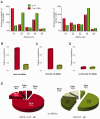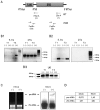A pathogenic non-coding RNA induces changes in dynamic DNA methylation of ribosomal RNA genes in host plants
- PMID: 24178032
- PMCID: PMC3919566
- DOI: 10.1093/nar/gkt968
A pathogenic non-coding RNA induces changes in dynamic DNA methylation of ribosomal RNA genes in host plants
Abstract
Viroids are plant-pathogenic non-coding RNAs able to interfere with as yet poorly known host-regulatory pathways and to cause alterations recognized as diseases. The way in which these RNAs coerce the host to express symptoms remains to be totally deciphered. In recent years, diverse studies have proposed a close interplay between viroid-induced pathogenesis and RNA silencing, supporting the belief that viroid-derived small RNAs mediate the post-transcriptional cleavage of endogenous mRNAs by acting as elicitors of symptoms expression. Although the evidence supporting the role of viroid-derived small RNAs in pathogenesis is robust, the possibility that this phenomenon can be a more complex process, also involving viroid-induced alterations in plant gene expression at transcriptional levels, has been considered. Here we show that plants infected with the 'Hop stunt viroid' accumulate high levels of sRNAs derived from ribosomal transcripts. This effect was correlated with an increase in the transcription of ribosomal RNA (rRNA) precursors during infection. We observed that the transcriptional reactivation of rRNA genes correlates with a modification of DNA methylation in their promoter region and revealed that some rRNA genes are demethylated and transcriptionally reactivated during infection. This study reports a previously unknown mechanism associated with viroid (or any other pathogenic RNA) infection in plants providing new insights into aspects of host alterations induced by the viroid infectious cycle.
Figures




Similar articles
-
Genome-wide DNA methylation analysis of CBCVd-infected hop plants (Humulus lupulus var. "Celeia") provides novel insights into viroid pathogenesis.Microbiol Spectr. 2025 Jun 3;13(6):e0039424. doi: 10.1128/spectrum.00394-24. Epub 2025 Apr 16. Microbiol Spectr. 2025. PMID: 40237512 Free PMC article.
-
Replication of a pathogenic non-coding RNA increases DNA methylation in plants associated with a bromodomain-containing viroid-binding protein.Sci Rep. 2016 Oct 21;6:35751. doi: 10.1038/srep35751. Sci Rep. 2016. PMID: 27767195 Free PMC article.
-
Changes in the DNA methylation pattern of the host male gametophyte of viroid-infected cucumber plants.J Exp Bot. 2016 Oct;67(19):5857-5868. doi: 10.1093/jxb/erw353. Epub 2016 Oct 3. J Exp Bot. 2016. PMID: 27697787 Free PMC article.
-
Viroid pathogenesis: a critical appraisal of the role of RNA silencing in triggering the initial molecular lesion.FEMS Microbiol Rev. 2020 May 1;44(3):386-398. doi: 10.1093/femsre/fuaa011. FEMS Microbiol Rev. 2020. PMID: 32379313 Review.
-
Viroids: how to infect a host and cause disease without encoding proteins.Biochimie. 2012 Jul;94(7):1474-80. doi: 10.1016/j.biochi.2012.02.020. Epub 2012 Feb 23. Biochimie. 2012. PMID: 22738729 Review.
Cited by
-
PSTVd infection in Nicotiana benthamiana plants has a minor yet detectable effect on CG methylation.Front Plant Sci. 2023 Oct 31;14:1258023. doi: 10.3389/fpls.2023.1258023. eCollection 2023. Front Plant Sci. 2023. PMID: 38023875 Free PMC article.
-
Genome-wide DNA methylation analysis of CBCVd-infected hop plants (Humulus lupulus var. "Celeia") provides novel insights into viroid pathogenesis.Microbiol Spectr. 2025 Jun 3;13(6):e0039424. doi: 10.1128/spectrum.00394-24. Epub 2025 Apr 16. Microbiol Spectr. 2025. PMID: 40237512 Free PMC article.
-
A nuclear-replicating viroid antagonizes infectivity and accumulation of a geminivirus by upregulating methylation-related genes and inducing hypermethylation of viral DNA.Sci Rep. 2016 Oct 14;6:35101. doi: 10.1038/srep35101. Sci Rep. 2016. PMID: 27739453 Free PMC article.
-
Replication of a pathogenic non-coding RNA increases DNA methylation in plants associated with a bromodomain-containing viroid-binding protein.Sci Rep. 2016 Oct 21;6:35751. doi: 10.1038/srep35751. Sci Rep. 2016. PMID: 27767195 Free PMC article.
-
Non-Random Genome Editing and Natural Cellular Engineering in Cognition-Based Evolution.Cells. 2021 May 7;10(5):1125. doi: 10.3390/cells10051125. Cells. 2021. PMID: 34066959 Free PMC article. Review.
References
-
- Ding B. The biology of viroid-host interactions. Annu. Rev. Phytopathol. 2009;47:105–131. - PubMed
-
- Ding B. Viroids: self-replicating, mobile, and fast-evolving noncoding regulatory RNAs. Wiley Interdiscip. Rev. RNA. 2010;1:362–375. - PubMed
-
- Navarro B, Gisel A, Rodio ME, Delgado S, Flores R, Di Serio F. Viroids: how to infect a host and cause disease without encoding proteins. Biochimie. 2012;94:1474–1480. - PubMed
-
- Zhao Y, Owens RA, Hammond RW. Use of a vector based on potato virus X in a whole plant assay to demonstrate nuclear targeting of potato spindle tuber viroid. J. Gen. Virol. 2001;82:1491–1497. - PubMed
Publication types
MeSH terms
Substances
Associated data
LinkOut - more resources
Full Text Sources
Other Literature Sources

